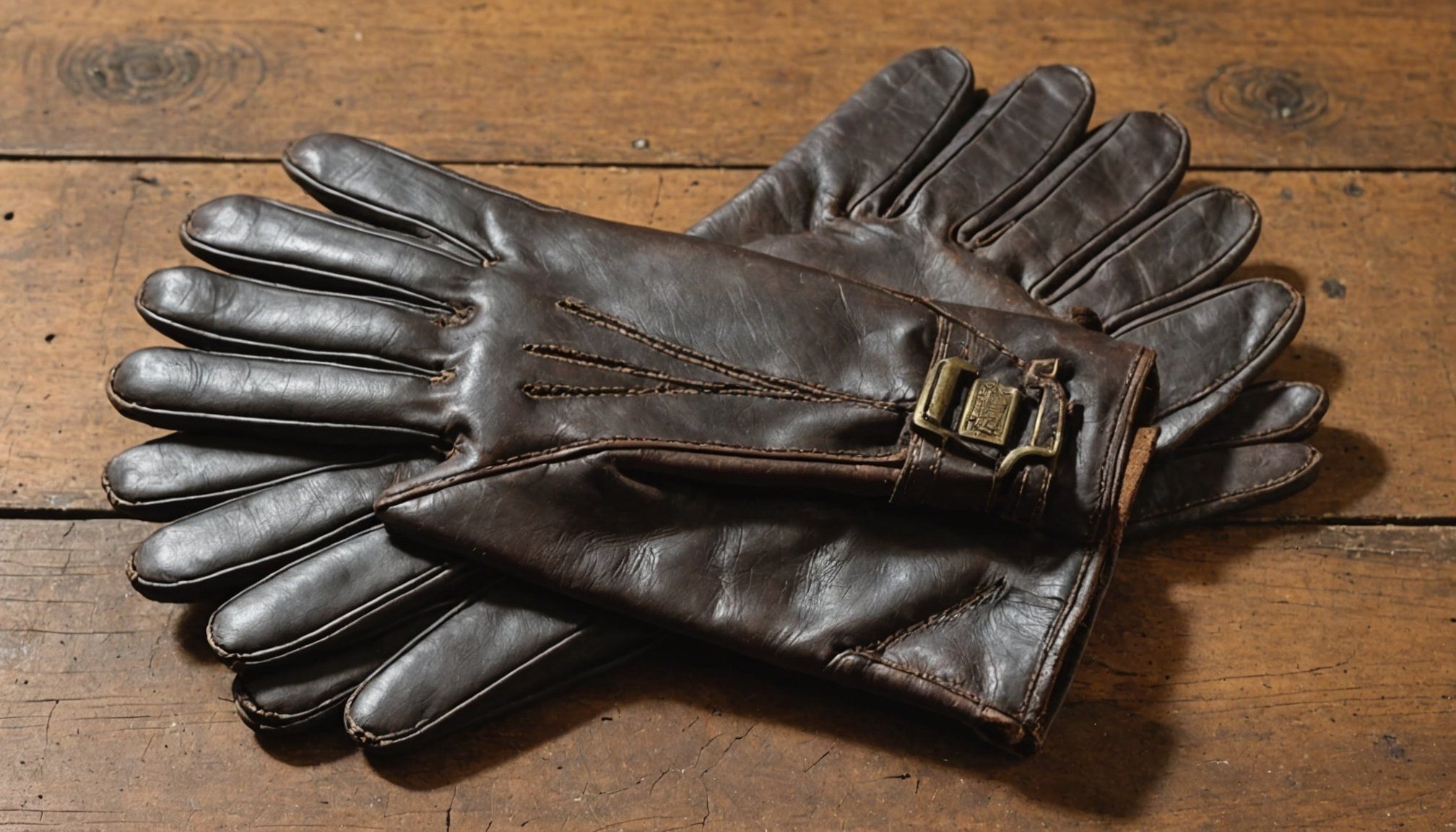Overview of Antique Leather Gloves
Antique leather gloves hold a rich history and significant cultural value, reflecting styles from different eras. Initially crafted for both utility and fashion, these gloves were a hallmark of sophistication. Popular styles varied from elegant evening gloves to rugged riding gloves, each serving specific functions and societal roles.
In the past, leather gloves were made from various materials, including kid leather and suede, prized for their softness and durability. The craftsmanship involved detailed stitching, leaving a legacy treasured by collectors today. The interest in history and style often leads enthusiasts to explore thrift store finds in the UK, where one might unearth hidden treasures.
Also read : Essential guide to restoring classic leather jackets discovered in uk marketplaces
Sourcing antique leather gloves involves patience and a keen eye. Thriving thrift stores across the UK offer an exciting hunt, making every find unique. It’s about understanding the glove’s past, and its place in history.
For those interested in these gloves, each piece tells a story. Whether found in the back of a thrift store or purchased online, these gloves carry the weight of history, awaiting new tales to join their legacy. The hunt for such vintage treasures is as exciting as the find itself.
Topic to read : Ultimate guide to non-slip shoes perfect for navigating the uk”s rainy weather
Assessing Condition Before Restoration
When embarking on the restoration journey of antique leather gloves, it is vital to conduct a thorough glove condition assessment. Begin by examining the key indicators of wear and damage, such as worn-out seams, discolouration, and thinning areas. These indicators help determine the extent of restoration required and ensure the glove retains its historical essence.
Proper inspection is crucial before initiating any restorative processes. Without this step, one risks further harm to the gloves, potentially diminishing their value or causing irreversible damage. A magnifying glass and ample lighting are invaluable tools for an in-depth inspection, revealing subtle imperfections.
During this inspection, consider using tools like a soft brush to gently remove dust, allowing for a clearer view of any damage. For more intricate details, employ a stitching awl to inspect the sturdiness of the seams. Recognising signs of wear and tear accurately leads to more informed restoration efforts, ultimately preserving the gloves’ structural integrity and historical narrative.
Focusing on an accurate assessment paves the way for successful restoration, ensuring these pieces of history remain adored collectibles for future generations. Be meticulous in this assessment to maintain the gloves’ authenticity and charm.
Cleaning Techniques for Antique Leather Gloves
When it comes to cleaning leather gloves, especially antiques, precision is key. Using harsh chemicals can cause irreparable damage. Instead, choose pH-balanced cleaning products specifically designed for leather.
Recommended tools include soft cloths and horsehair brushes. Start with a gentle dusting using the brush, followed by wiping with a damp, lint-free cloth to remove surface dirt. Avoid soaking the leather, as excess moisture alters its texture.
To address stubborn stains without harming the gloves, create a solution of mild soap and water. Apply sparingly with a soft sponge, ensuring no overwetting. Test solutions on an inconspicuous area first to guarantee no discolouration occurs.
Tips for cleaning processes focus on gentle motions and patience. Always allow gloves to air dry naturally, away from direct heat sources, which can cause the leather to crack. Once cleaned, lightly buff with a dry cloth for that extra shine.
These consistent, careful cleaning methods not only protect the gloves’ structure but also preserve their historical beauty, ensuring they remain cherished artefacts for years to come.
Conditioning Leather for Longevity
Ensuring longevity in antique leather gloves relies heavily on proper conditioning. It’s the cornerstone of leather restoration, essential for maintaining the gloves’ softness and preventing cracks. Antique leather, given its age, is often dry and requires rejuvenation.
When choosing restoration products, opt for conditioners specifically designed for antique leather. Mink oil and lanolin-based products are popular choices, providing both nourishment and a protective barrier. Always avoid heavy or synthetic oils, which can saturate the leather, causing it to lose its original texture.
Applying the conditioner involves a careful, systematic approach. First, ensure the gloves are free from dust and dirt using a soft cloth. Once clean, apply a small amount of conditioner to a lint-free cloth and gently massage it onto the leather in circular motions. This encourages absorption and even distribution. Allow the gloves to air dry naturally and repeat if necessary.
Tips for conditioning focus on moderation and patience. Over-application can lead to greasy residue, diminishing the glove’s appearance. By conditioning judiciously, you preserve not only the leather’s physical integrity but also its historical charm, ensuring these timeless pieces endure for future admiration.
Repairing Damage on Antique Leather Gloves
Restoring antique leather gloves often involves addressing common types of damage, ensuring they regain their original charm. Frequent issues include small tears, loose seams, and scuffed surfaces. To repair these, basic skills in patching and stitching are essential.
Begin by closely inspecting the gloves for damage. Employ a needle and strong thread for stitching torn seams, using careful, even stitches. For minor surface damage, use a leather patch and adhesive. Ensure any patch is slightly larger than the tear, providing a firm grip and discreet fix. Applying a patch involves a systematic process: cut the patch to size, apply adhesive around the tear, and press firmly, leaving it to set.
Recommended tools include a curved needle, thimble, and high-quality leather adhesive. Adhesives like rubber cement provide flexibility, vital for gloves’ movement. Maintaining patience and precision, allow repairs to dry thoroughly.
These fundamental repair techniques not only revive the gloves’ aesthetics but also preserve their historical value. Applying the right tools and methods ensures that these timeless pieces continue to be elegant, cherished artefacts. Such restoration efforts highlight the craftsmanship and care required to maintain these historical treasures.
Recommended Products for Leather Restoration
In the realm of leather restoration, selecting the right products is crucial for preserving your antique leather gloves. Begin by exploring essential items such as leather conditioners, cleaners, and adhesives. These are the backbone of any restoration toolkit.
Leather restoration products come in various forms, each with distinct benefits. Popular brands like “Lexol” and “Bickmore” are well-regarded for their conditioning prowess. These products help maintain the leather’s suppleness and prevent cracking. For cleaning, brands such as “Kiwi” provide gentle solutions tailored for delicate leather garments, ensuring safety and efficacy.
When it comes to purchasing these products, UK-based stores offer a wealth of options. Both physical shops, such as traditional cobbler outlets, and online platforms like Amazon UK provide access to top-tier brands. Leveraging these resources allows restorers to find the ideal product for their specific needs.
A thorough comparison of these restoration products, using online reviews and expert suggestions, helps in identifying the most effective solutions within the market. Through thoughtful selection, the gloves can be maintained and appreciated across generations, celebrating both their beauty and historical significance. Quality products not only rejuvenate the leather but also uphold its legacy.
Identifying Valuable Antique Leather Gloves
Exploring the collector’s market requires an informed eye to differentiate between ordinary and valuable leather gloves. Characteristics that denote value often include rarity, craftsmanship, provenance, and condition. These factors contribute to determining a glove’s desirability among collectors.
The process of appraisal involves understanding an item’s history and materials. Unique designs and well-preserved stitching can significantly enhance a glove’s worth. Gloves associated with notable historical figures or events might also fetch higher interest. Additionally, any accompanying documentation or provenance certificates can amplify value assessments.
When venturing into thrift stores, maintain a focused approach. Regular visits to various locations increases the likelihood of discovering hidden gems. Engage store staff who might share insights about recent acquisitions or hold items of interest. Often, the knowledge shared among thrift enthusiasts provides invaluable leads.
To enhance valuation accuracy, consider anecdotes or case studies of successful appraisals. For instance, a perfectly preserved pair of ceremonial gloves from the early 20th century once found in a small London thrift shop garnered considerable interest at auction, exemplifying how astute observation pays dividends. Engaging with communities dedicated to vintage finds can offer valuable perspectives and stories.
Photography and Documentation of Your Restoration
Documenting your restoration journey of antique leather gloves not only captures the transformation process but also adds a significant layer to their history. To begin with, photography plays a crucial role. When done properly, it conveys the texture and details of the leather beautifully. Use a camera with a high-resolution lens and ensure good lighting conditions, avoiding harsh direct light which could cause glare. A lightbox can provide professional results by diffusing light evenly.
Consider using the macro mode for close-ups—this is particularly effective for highlighting intricate stitching or detailing that defines the gloves’ era. Tripods help stabilize your shots, ensuring clarity and focus, especially in low light.
Crafting a visual narrative through photographs showcases the gloves’ journey from worn to wonderful. Capture images throughout the restoration process to illustrate their before-and-after condition.
Lastly, share your journey on social media platforms or personal blogs to connect with fellow enthusiasts and collectors. This not only adds to the communal knowledge but also builds a visual archive of your cherished finds. Engaging with these communities brings valuable feedback and fosters a shared appreciation of vintage restorations.
Personal Stories from Thrift Stores
Discovering thrift store finds, especially in the form of antique leather gloves, often leads to fascinating personal stories. Many enthusiasts relish the opportunity to uncover these hidden jewels, each piece sparking joy akin to a modern-day treasure hunt. The thrill lies not only in the restoration but also in the anecdotes that accompany these cherished objects.
Engaging narratives from such expeditions reveal both surprises and challenges faced during restoration stories. Take, for instance, a collector who stumbled upon a pair of elegant evening gloves dated back to the Edwardian era, nestled amidst a sea of modern clothing. The journey of bringing these gloves back to life unveiled lessons in patience and craftsmanship, all shared within a vibrant community of glove enthusiasts.
Participation in online forums allows restorers to relay their tales and personal anecdotes, exchanging experiences that foster a rich tapestry of knowledge and passion. Lessons learned often emphasize the importance of recognising subtle signs of authenticity and employing gentle restoration techniques. These exchanges not only breathe new life into each pair of gloves but also cultivate a sense of camaraderie amongst those dedicated to reviving antique legacies. Through shared stories, the joy of reviving these artifacts grows exponentially.








